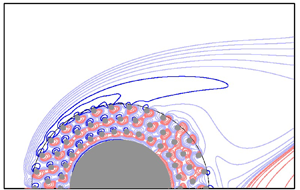Published online by Cambridge University Press: 27 October 2021

The effects of porous material on the aeroacoustic sound generated in a two-dimensional low-Reynolds-number flow ( $Re=150$) past a circular cylinder are studied by direct numerical simulation in which the acoustic waves of small amplitudes are obtained directly as a solution to the compressible Navier–Stokes equations. Two models are introduced for the porous material: the microscopic model, in which the porous material is a collection of small cylinders, and the macroscopic model, in which the porous material is continuum characterized by permeability. The corrected volume penalization method is used to deal with the core cylinder, the small cylinders and the porous material. In the microscopic model, significant reduction of the aeroacoustic sound is found depending on the parameters; the maximum reduction of
$Re=150$) past a circular cylinder are studied by direct numerical simulation in which the acoustic waves of small amplitudes are obtained directly as a solution to the compressible Navier–Stokes equations. Two models are introduced for the porous material: the microscopic model, in which the porous material is a collection of small cylinders, and the macroscopic model, in which the porous material is continuum characterized by permeability. The corrected volume penalization method is used to deal with the core cylinder, the small cylinders and the porous material. In the microscopic model, significant reduction of the aeroacoustic sound is found depending on the parameters; the maximum reduction of  $24.4$ dB from the case of a bare cylinder is obtained. The results obtained for the modified macroscopic model are in good agreement with those obtained for the microscopic model converted by the theory of homogenization, which establishes that the microscopic and macroscopic models are consistent and valid. The detailed mechanism of sound reduction is elucidated. The presence of a fluid region between the porous material and the core cylinder is important for sound reduction. When the sound is strongly reduced, the pressure field behind the cylinder becomes nearly uniform with a high value to stabilize the shear layer in the wake; as a result, the vortex shedding behind the cylinder is delayed to the far wake to suppress the unsteady vortex motion near the cylinder, which is responsible for the aeroacoustic sound.
$24.4$ dB from the case of a bare cylinder is obtained. The results obtained for the modified macroscopic model are in good agreement with those obtained for the microscopic model converted by the theory of homogenization, which establishes that the microscopic and macroscopic models are consistent and valid. The detailed mechanism of sound reduction is elucidated. The presence of a fluid region between the porous material and the core cylinder is important for sound reduction. When the sound is strongly reduced, the pressure field behind the cylinder becomes nearly uniform with a high value to stabilize the shear layer in the wake; as a result, the vortex shedding behind the cylinder is delayed to the far wake to suppress the unsteady vortex motion near the cylinder, which is responsible for the aeroacoustic sound.